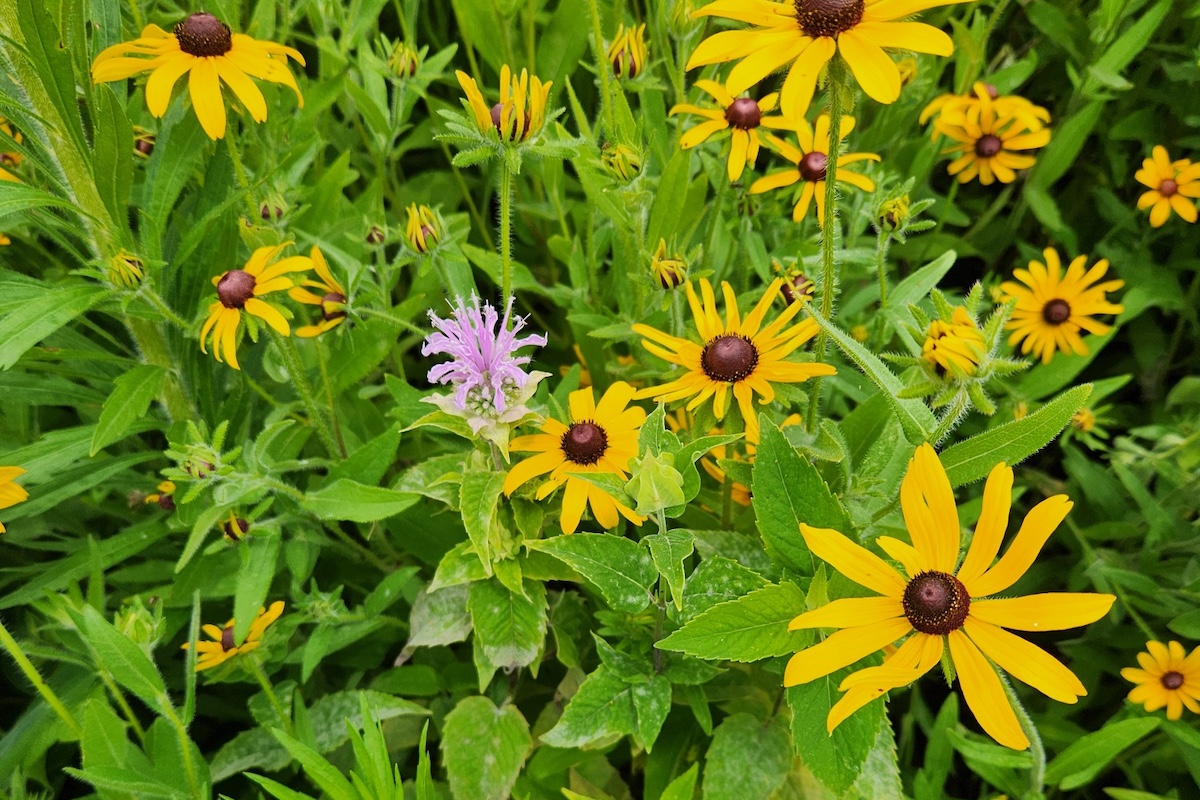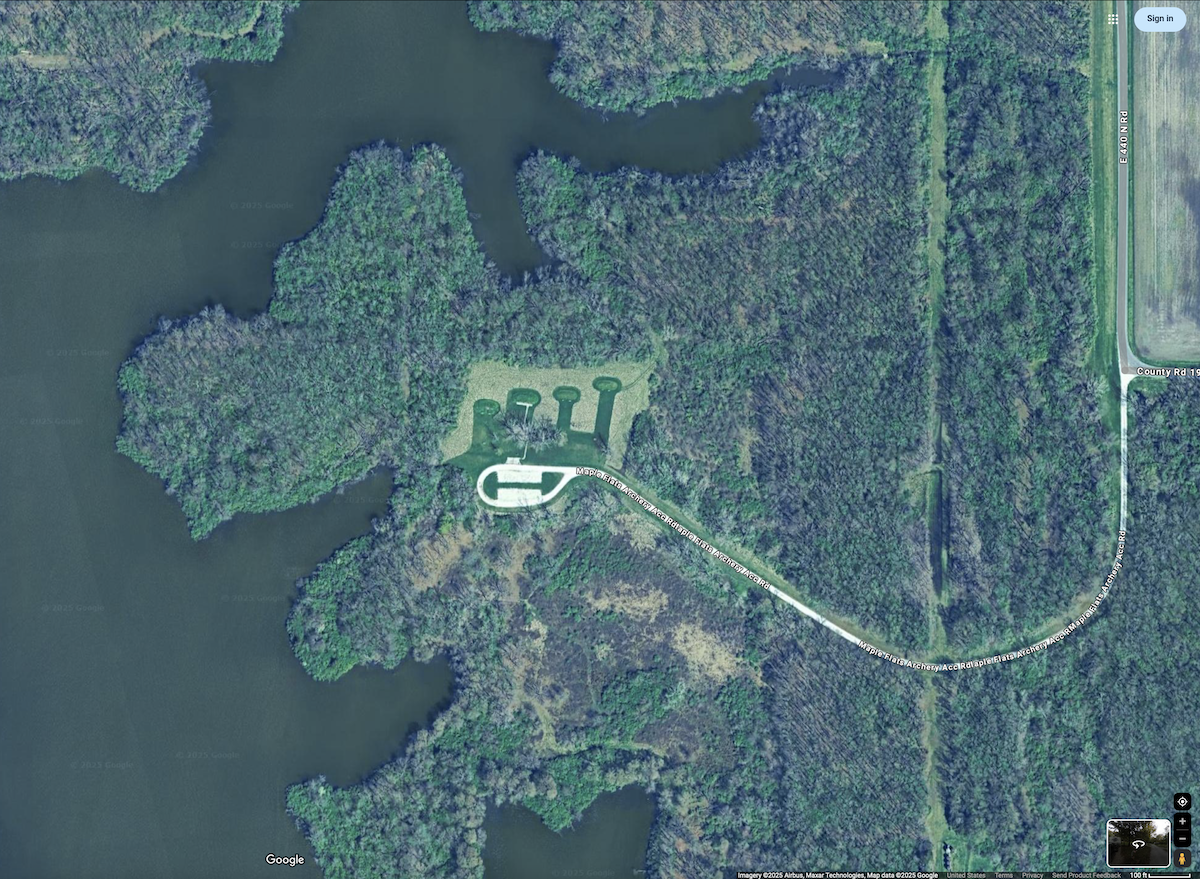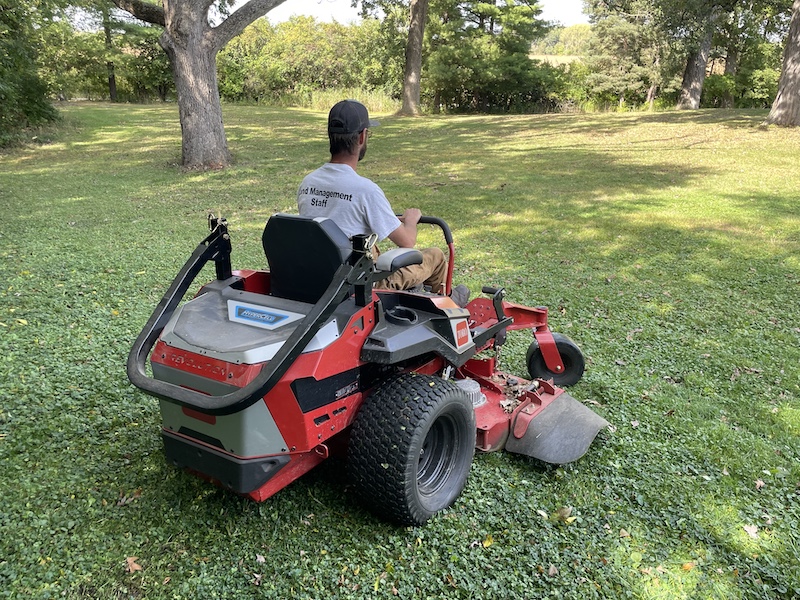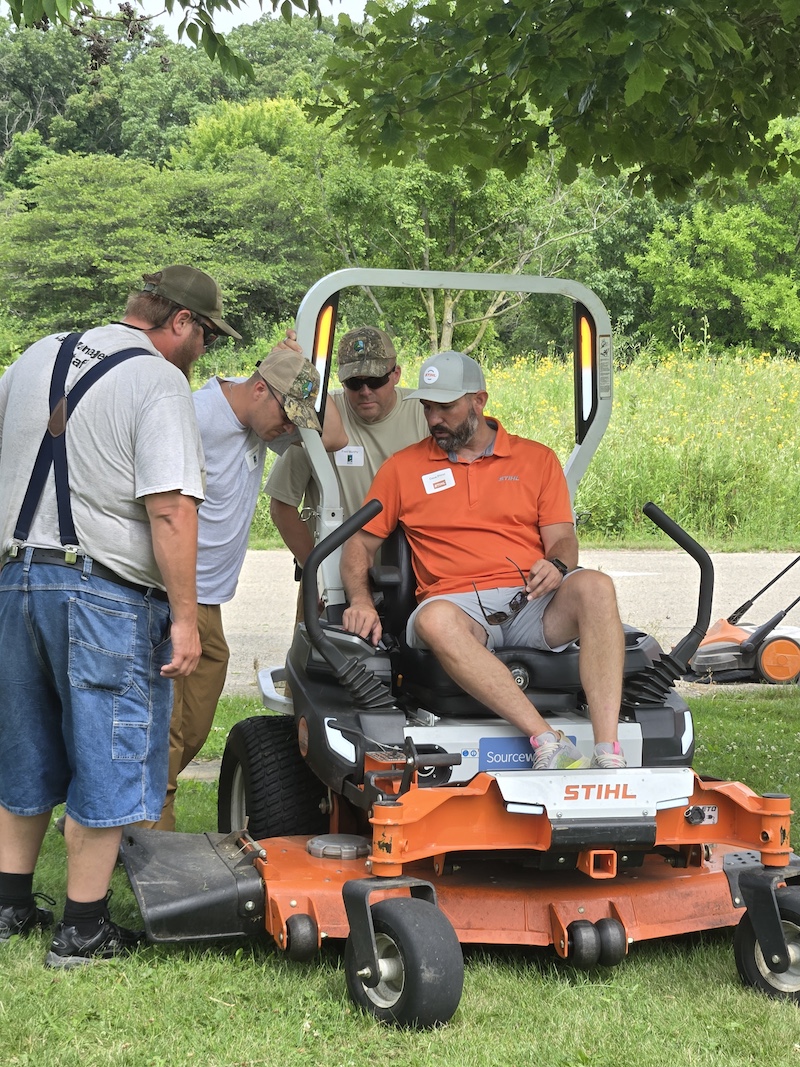
Less than 1 percent of Illinois’ original prairie remains. The Illinois Department of Natural Resources is committed to providing opportunities for the public to experience the native habitats that once covered Illinois. Photo by Jamie Hopper.



Less than 1 percent of Illinois’ original prairie remains. The Illinois Department of Natural Resources is committed to providing opportunities for the public to experience the native habitats that once covered Illinois. Photo by Jamie Hopper.
Jamie Hopper measures success by the presence of the covey of quail outside his office window. And the hen turkey and her poults foraging in the seed- and insect-rich grasses existing there.
For the past two years, Hopper, Site Superintendent at Sangchris Lake State Park, a 3,000 acre site located just south of Springfield, and his staff have intentionally decreased the amount of mowing conducted each week. Many such areas are naturally reverting to native vegetation although some are seeded with prairie grasses and forbs. The most visible payoff has been an increase in wildlife.
“The former site management plan meant that staff were on mowers five days every week during the growing season,” Hopper explained. “Under the Plan of Work developed in 2024, after completion of Illinois Department of Natural Resources’ (IDNR) Climate Action Plan (see Sidebar), we have reduced the number and size of areas mowed, freeing up an average of two days a week to concentrate on other activities at the park, such as habitat management and maintenance of boat ramps, campgrounds and picnic areas.”
Many IDNR sites and staff have shifted toward the use of electric mowers, chain saws and weed whackers, and are converting turfgrass areas into wildlife habitat. Here we’ll highlight just a few sites and the sustainable land management practices under way as inspiration for undertaking practical, cost-effective habitat improvement projects that create thriving game habitat, prairies or other ecosystems, better support pollinators, increase species diversity of sites and improve runoff.
As a member of the IDNR Climate Action Plan, Tom Hintz heard a consistent recommendation from the various committees: IDNR should remove turf grass and plant prairie grasses wherever, and whenever, appropriate.
When Hintz became the Site Superintendent at Lincoln Trail State Park, a 1,023-acre park in Clark County, he immediately set into action a plan to reduce mowing, a strategy based on the success he had realized while superintendent at Jubilee College State Park located west of Peoria.
“The mowing reduction effort at Jubilee began in 2004 after conversations I had with the IDNR wildlife biologist to identify fields of fescue not needed as public use sites,” Hintz explained. “We converted those areas into corn and beans for three to five years with the revenue generated used to purchase prairie seeds for our ultimate goal of developing prairie restorations.”
Hintz continues to be amazed at how quickly prairies can develop, and in turn, how rapidly wildlife—butterflies and other insects, bobwhite quail, songbirds and more—responds.
“As a conservation professional I am committed to showcasing Illinois as the Prairie State,” he explained. “In my mind that means a better use of park staff is to replace expanses of turf grass with quality wildlife habitat.”
For Hopper, the Sangchris project has entailed mowing a pattern in front of each target at the archery range rather than acres of grass. And instead of mowing 15-foot swaths along the roadsides, a single 6-foot strip saves considerable time and energy and increases food resources for wildlife.

Cassie Carroll, Assistant Director of the EnergySense Resilience Center at the University of Illinois calculated the annual savings realized through reduced mowing at Sangchris Lake State Park:
“The actions at Sangchris alone equates to a reduction of 10.6 metric tons of carbon dioxide entering the atmosphere,” Carroll said. “With more than 290 state parks and other recreational areas managed by IDNR, the overall impact to the environment is significant.”
Like his counterparts throughout the state, Jacob Shurpit, Site Superintendent at Moraine Hills State Park, a 2,200-acre site in McHenry County, and Volo Bog State Natura Area, another Lake County site centered around an ancient glacial kettle hole lake, is looking at ways to combat use of staff time and implement environmentally friendly practices. His work plans include a reduction in mowing, conversion of areas to native vegetation and serving as the flagship IDNR facility testing the suitability of site maintenance using an electric mower.

With a full year of experience with an electric mower, Shurpit and his staff couldn’t be more pleased with the results.
“In terms of the daily capacity of the equipment there is no difference,” Shurpit explained. “Staff are able to mow about 8 hours and cover 8 acres, just as we could with a diesel mower, then we charge the batteries overnight and are back out the next day.”
The use of diesel and electric mowers differs on a couple of key aspects.
“There has been a huge reduction in the amount of maintenance required for the mower,” Shurpit noted. “Our diesel mower is typically down about every three months for maintenance. After a year the electric mower has had no downtime and only requires basic upkeep.”
Another difference between the two types of mowers has been a noticeable reduction in noise.
“Park visitors have remarked how much quieter the electric mowers are and staff conducting public events appreciate how much quieter it is working in proximity to the electric mower,” he continued. “We’re also convinced that the impact to wildlife has significantly decreased given the reduction of noise levels.”
The final decision on the long-term value of the electric mowers awaits learning how long the batteries last. At this point in time, however, all involved with the use of electric mowers at the Lake County sites are happy and impressed.

One immediate action growing out of the Climate Action Plan was to provide IDNR staff with opportunities to enhance their knowledge of climate-friendly alternatives for management of park properties, with a focus on electric tools.
As seasoned site superintendents, both Hopper and Hintz were sceptics that electric tools would be durable enough to keep up with demands of managing large tracts of public property. But they kept open minds and put them to test at a demonstration arranged for IDNR staff.
Hopper admits he was quick to convert to the idea of electric mowers after having the opportunity to run one during a demonstration workshop. But he took a little more convincing about electric chainsaws.
“I watched the electric chainsaw quickly go through a stack of firewood but questioned how it would handle taking down a standing tree,” he said. “Seeing a dead tree nearby, I asked the site superintendent if I could drop it with the demonstration saw. The electric saw handled that task as well as a gas-powered saw but without the noise or emission. I was convinced.”
Hintz and the Lincoln Trail staff have been using electric chainsaws for five years.
“When managing trails for public safety, electric chainsaws allow you to quickly and quietly work your way down a trail, clearing limbs with a simple push of a button,” Hintz explained. “We find that electric weed whackers are much quieter than gas powered models, which maintains an environment of peace and quiet that park visitors seek.”
User safety is another benefit of electric equipment as site staff can easily communicate with each other while operating the equipment. Also, electric tools do not produce smoke, which is better for both the environment and the health of the operators. In addition, maintenance requires less time as electric tools have fewer parts to wear down.
Both superintendents admit that using electric tools does require numerous batteries and developing a work plan for the day, but under most situations a full day’s work is easily accomplished with their supply of batteries.
“Using electric tools reduces fossil fuel use and emissions and is one the goals identified in the Sustainable Site Operations section of IDNR’s Climate Action Plan,” Carroll added, noting that this is one of a multitude of benefits site staff can realize toward goals identified in the plan.
Carroll also explained that enhancing the level of native habitats increases the amount of carbon sequestration on IDNR lands, meeting the goal of increasing biological carbon sequestration and storage while enhancing and adding to the resilience of natural systems and species.
“Because of the hard work of site staff to mow less and transition grass and/or brush areas to native or game habitat, more resilient natural systems are being created throughout the state,” she explained.
“The Site Superintendent’s experiences mentioned in this article demonstrate that it is possible to utilize energy efficient equipment and focus our actions to improve habitat at the same time,” explained Calvin Beckmann, Chief of Parks and Recreation within IDNR’s Office of Land Management. “As the electric equipment reliability and durability improves, the Office of Land Management will continue to incorporate their use into the daily workflow until it becomes standard practice. Mowers, trimmers, chainsaws, etc. are just the beginning. I anticipate more equipment options as the technology improves.”
“Overall, the public has been receptive to the process of decreasing expansive swaths of non-native turf grasses,” Hintz said, noting that he had incredible conservationists as role models early in his career and credits them for his stubborn mindset of leaning on the side of conservation. “With a little knowledge about the history of Illinois, the Prairie State, and the mission of IDNR—To manage, conserve and protect Illinois’ natural, recreational and cultural resources, further the public’s understanding and appreciation of those resources, and promote the education, science and public safety of Illinois’ natural resources for present and future generations—people get behind the movement.”
Hopper admits that the development of a prairie plot may not be easy and it does require maintenance.
“In the beginning years you may have to get out and hand-pull weeds and you’ll spend some time talking to visitors about the transition under way,” he noted. “The first years won’t look like much but suddenly there will be a profusion of bee balm and coneflowers and other native plants that benefit pollinators and wildlife.”
Hopper is amazed at the resiliency of prairie plants.
“We often find species not included in the seed mixtures to spring up in the plots,” he said. “Given the opportunity, seeds that have laid dormant in the soil for decades have the opportunity to germinate and add to the diversity of our prairie restorations.”
And as both Hopper and Hintz experienced, the call of the bobwhite quail drifting across the prairie is a simple, yet rewarding, validation of their work.
“It only took a few years for the prairie plots along the entry road to Lincoln Trail State Park to develop,” Hintz said. “Today, people experience a natural bouquet of native wildflowers and enjoy seeing an abundance of different butterflies. And, if they are lucky and have their windows down, they’ll hear the welcoming call of the bobwhite quail.”
Kathy Andrews Wright retired from the Illinois Department of Natural Resources where she was editor of OutdoorIllinois magazine. She is currently the editor of OutdoorIllinois Journal.
Submit a question for the author